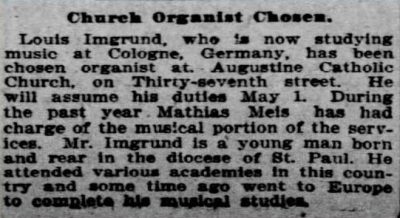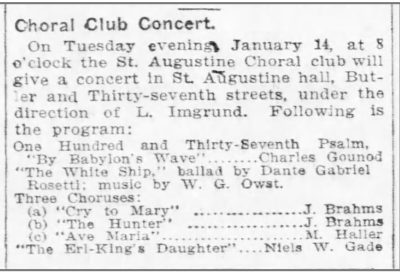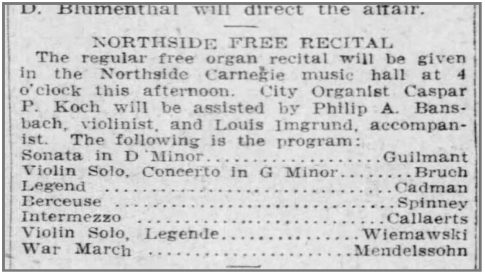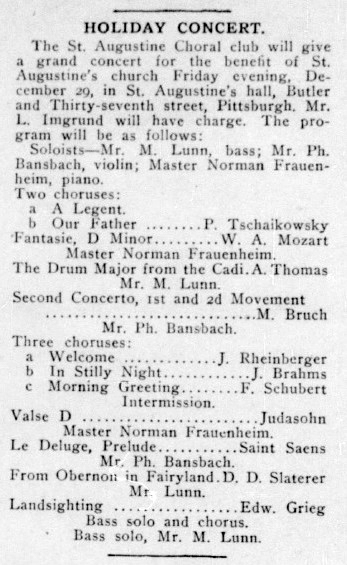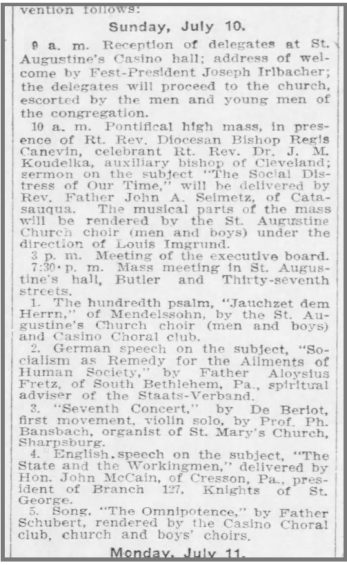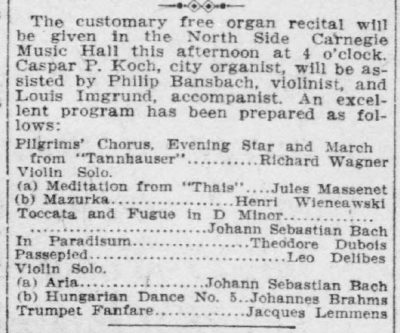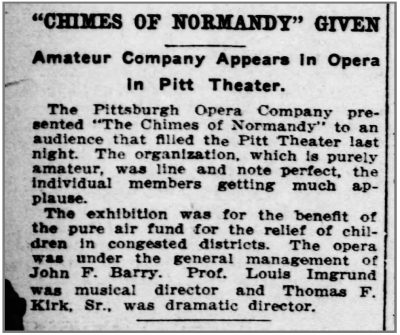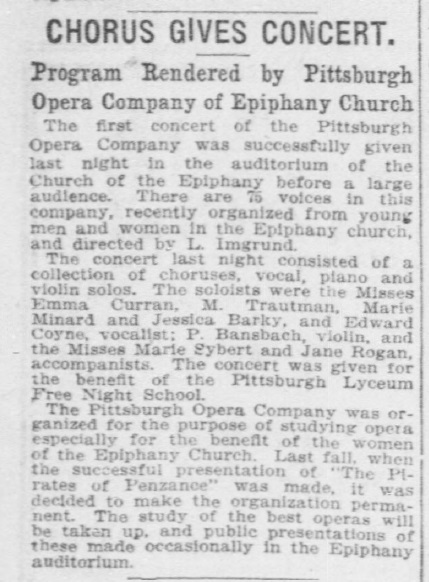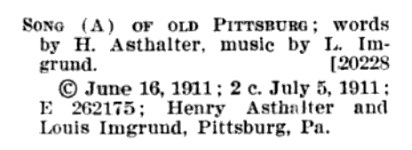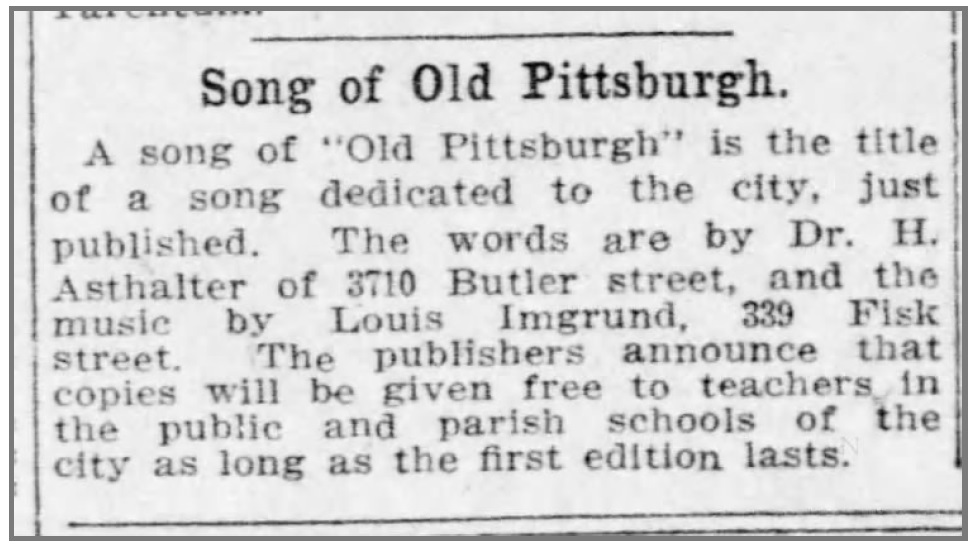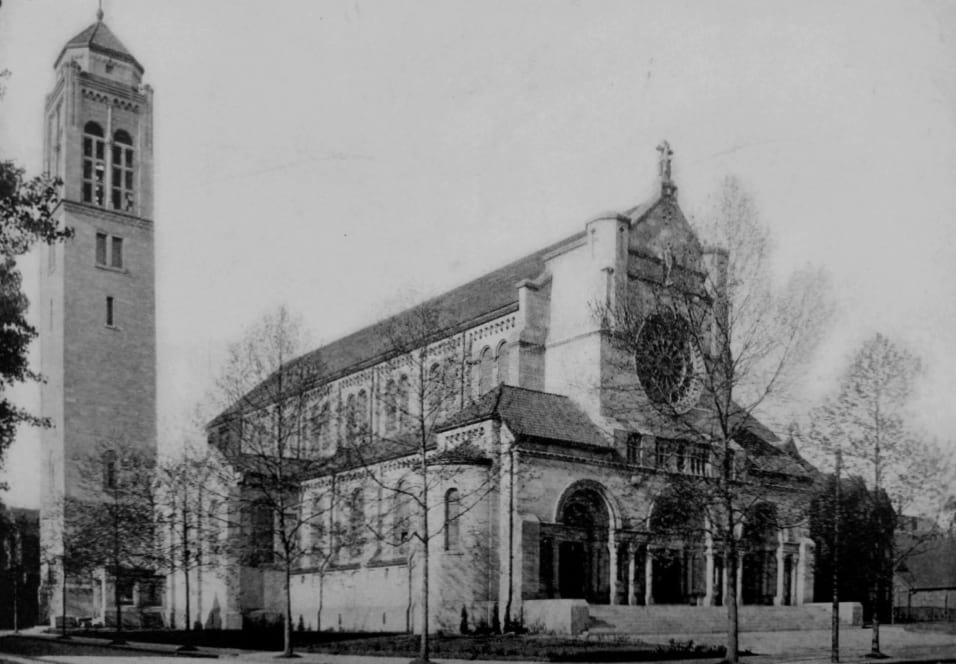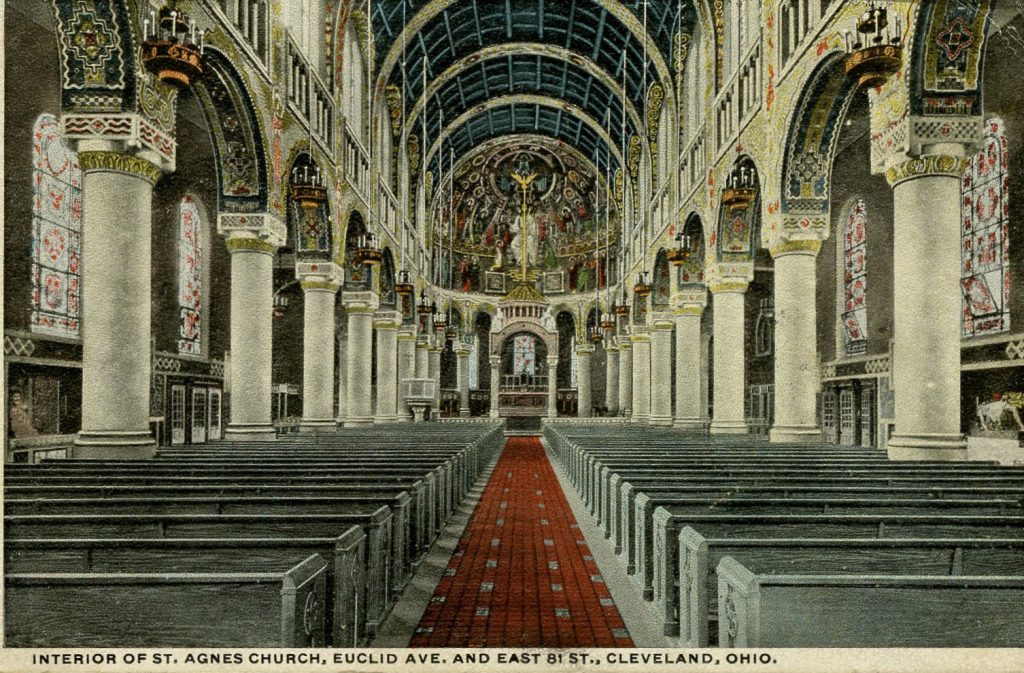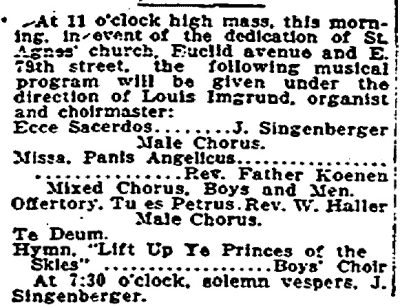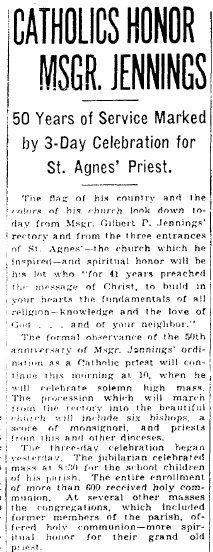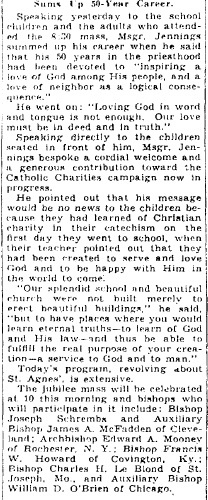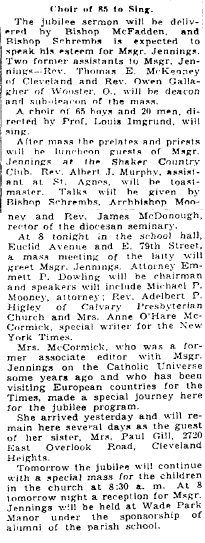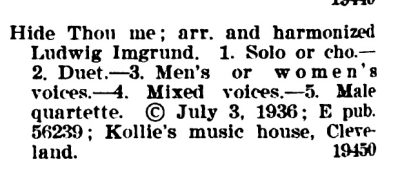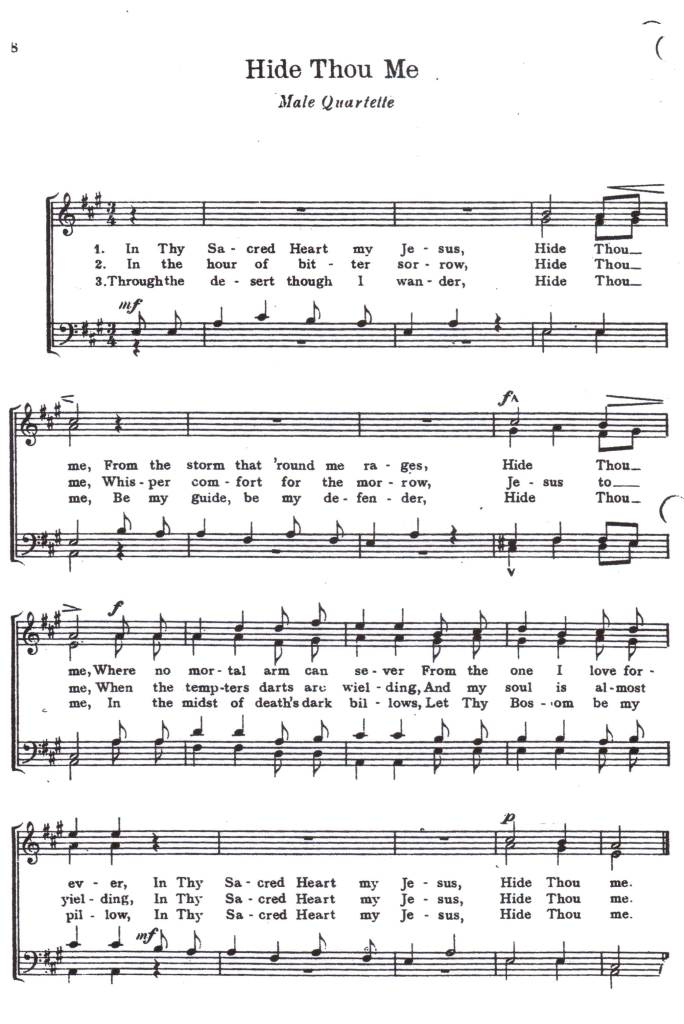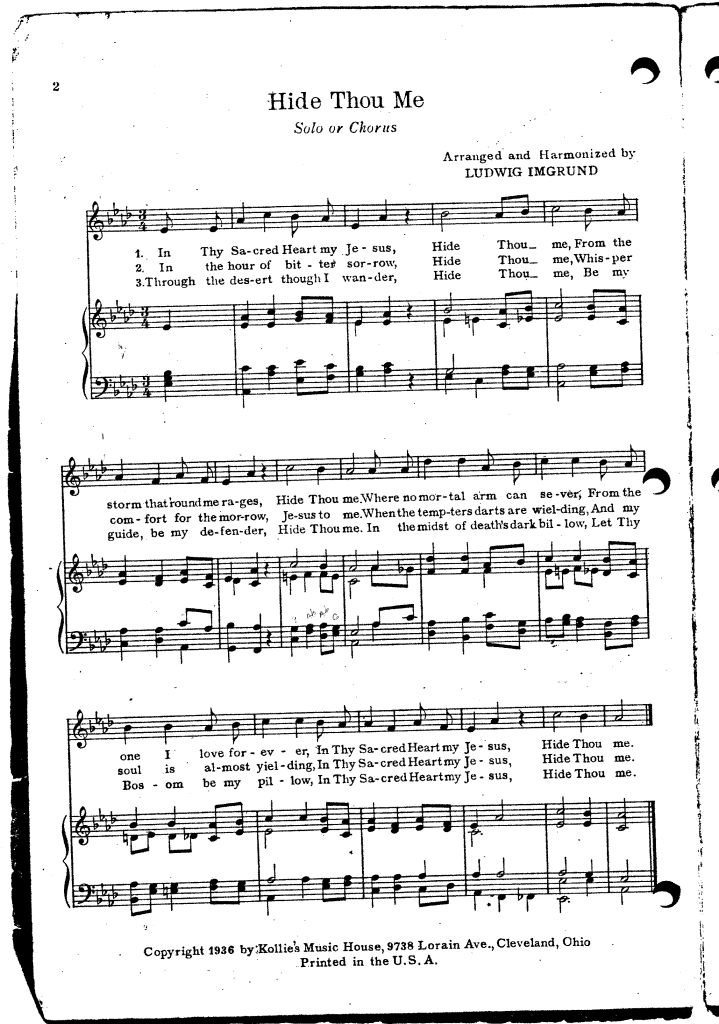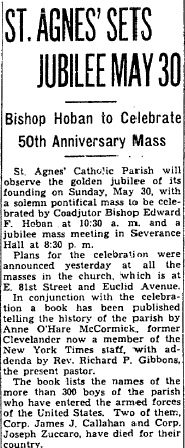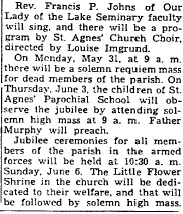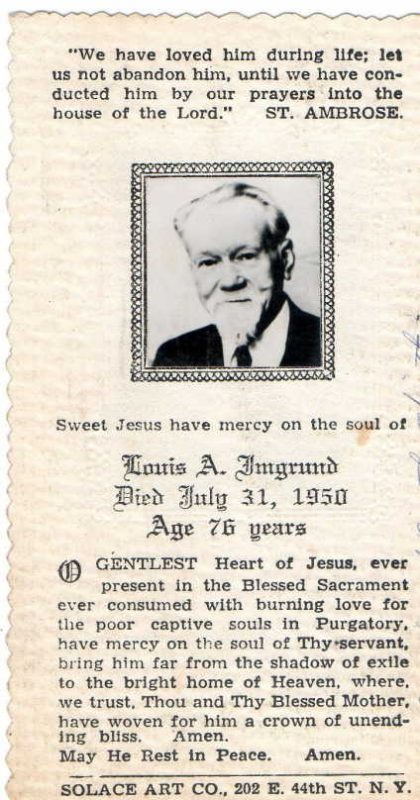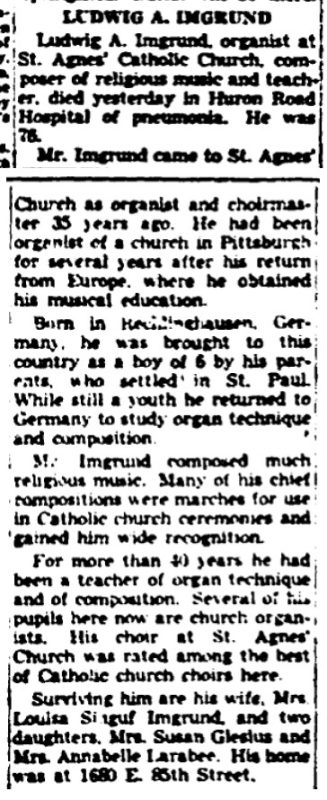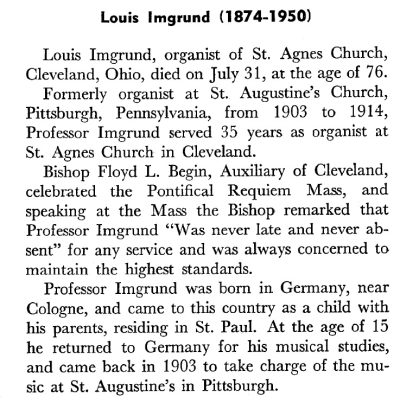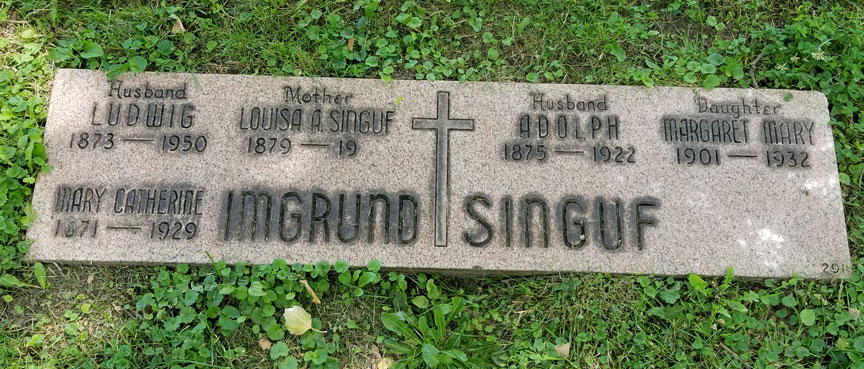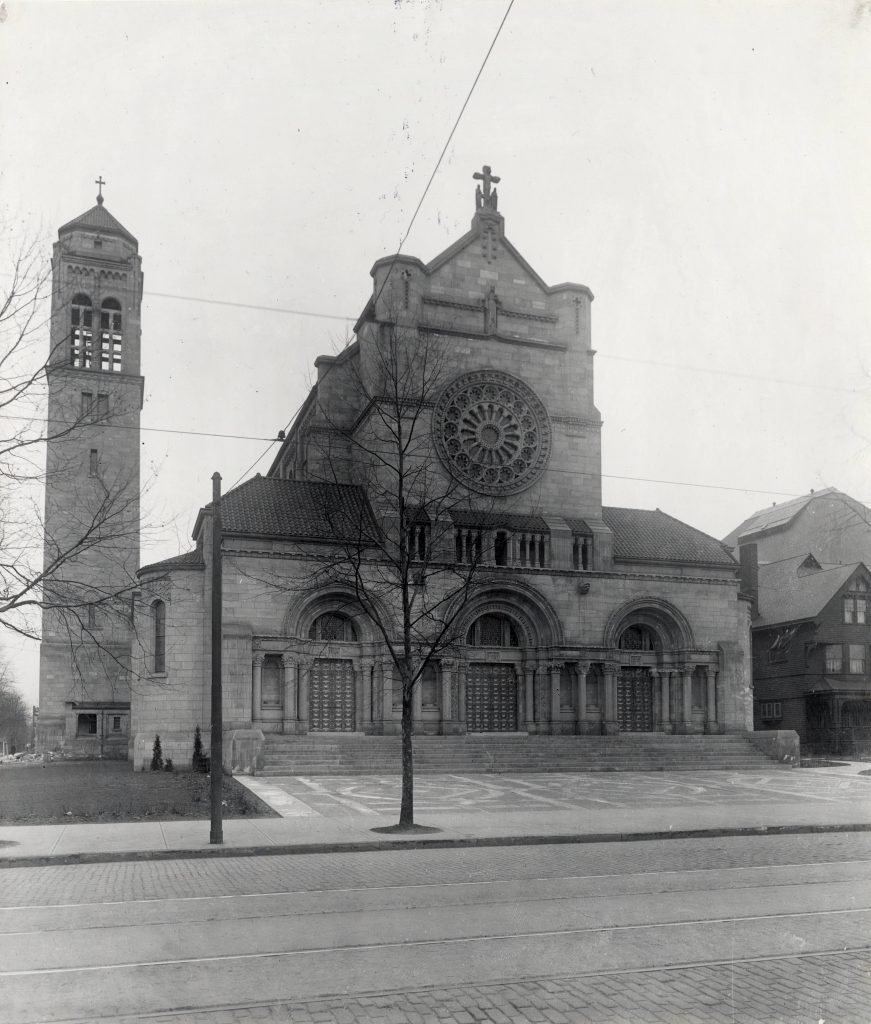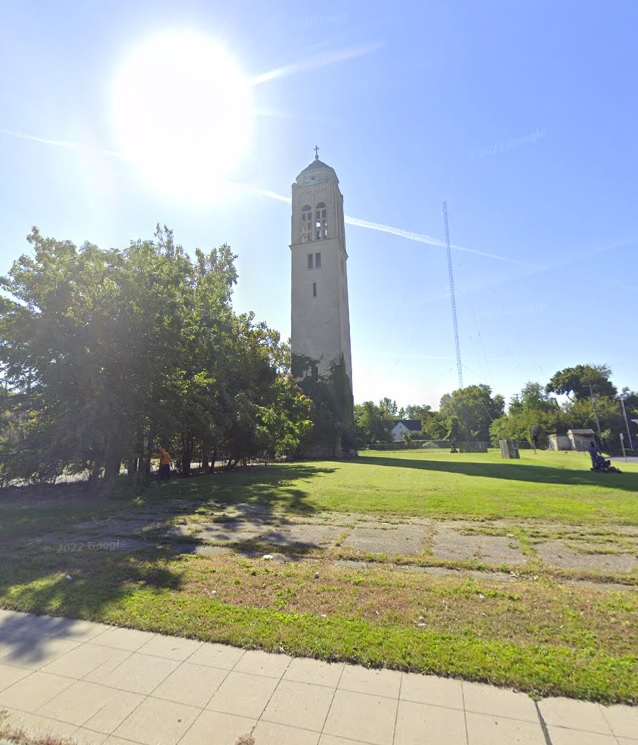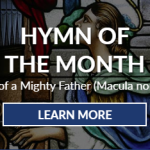This short write-up is about a local musician from Cleveland, Ohio. His name was Louis (Ludwig) Adolph Imgrund (1873-1950). Louis was an immigrant and organist at two Catholic parishes, a composer of both secular and sacred music, a teacher of organ technique and composition for more than forty years. He traveled to Germany on more than one occasion and applied for US Citizenship and took the Oath of Allegiance in 1913. The narrative of this work has been kept to a minimum to allow the documents to speak for themselves.
Louis (Ludwig) Imgrund is the composer of the hymn Hide Thou Me. Louis Imgrund immigrated to the United States with his father, mother and siblings and settled in St. Paul, Minnesota in 1880, he was six years old. His father was a wagon maker and as a young man Louis studied music at various academies and by his early twenties went to Cologne, Germany to complete his studies.
In 1902, while in Germany completing his studies, he received a commission to be the organist at St. Augustine Catholic Church in Pittsburgh, Pennsylvania. On May 6, 1903 he married his first wife Catherine Newberg. St. Augustine’s was a new church and was dedicated on May 12, 1901 and was under the jurisdiction of the Franciscan Friars. A detailed history of the Diamond Jubilee of St. Augustine Parish can be found online, a reference to Louis Imgrund can be found on page 163 and this is the only mention of him in this historical account. He was the choir director of the Casino Choral Club, a group of thirty-five singers consisting of both men and women. The Choral Club was established by the St. Augustine Casino Society which took their name from the old school hall.
Between 1910 and 1913, Louis was involved in directing and accompanying various organ recital’s, holiday concerts, and charity benefits including directing the first Pittsburgh Opera Concert. During this time, a musical piece, A Song of Old Pittsburgh, was published. The words were by Dr. H. Asthalter, and the music was composed by Louis Imgrund. He served as organist for St. Augustine’s Parish for about 15 years.
Around 1914/15, Louis, his wife, and two children moved to Cleveland, Ohio where he took the job of organist at St. Agnes Church. St. Agnes Parish was established to meet the pastoral needs of the German and Irish immigrant neighborhoods. The Rev. Gilbert Jennings was the first pastor, and the school was staffed by the Congregation of Saint Joseph. St. Agnes Parish was established in 1873 and by 1894 the growth of the parish necessitated expanding the church and construction of a new school building in 1904. St. Agnes High School for girls opened in 1911. The parish continued to grow and in March of 1914, ground was broken for a new church.
The new church was completed in 1916 and Louis Imgrund, organist and choirmaster directed the music at the dedication. A news article from the Cleveland Plain Dealer documents the event.
On August 15, 1929, just a few weeks after the family returned from a trip to Bremen, Germany, his wife of twenty-six years, Mary Catherine, died at home from cancer. She is buried at Calvary Cemetery in Cleveland, Ohio.
After his wife died, Louis opened his home to lodgers and according to the April 1930 census, Louisa Singuf and her daughter Margaret Singuf were lodgers. Louisa was well-connected with the larger music scene in Cleveland. Her name and that of her late husband Adolph Singuf appears in an advertisement from the 1919-1920 Second Season of Cleveland Orchestra which was conducted by Nikolai Sokoloff. Later that year, on October 11, 1930, Louis married Louisa A. Singuf. On January 22, 1932, Louisa’s daughter Margaret Mary died after suffering from a long illness. She is buried at Calvary Cemetery in Cleveland, Ohio.
On June 3, 1934, a three-day celebration took place for the Golden Jubilee of Msgr. Gilbert Jennings the first pastor of St. Agnes Church. Prof. Louis Imgrund conducted a choir of sixty-five boys and twenty men.
In 1936, Louis composed and arranged the hymn HIDE THOU ME. This hymn was published by Kollie’s Music House in Cleveland, Ohio. Kollie’s Music House was located along the 9700 block of Lorain Ave and was established on December 1, 1920 by J. P. Kollie and his sons. It was at first a small neighborhood store with a small stock of records and a small stock of instruments. It would become the recognized musical instrument place on the West Side of town and a leading supplier of Catholic Church Music. A second location was established on Hemlock Ave around 1923. Based on a review of archived city directories Kollie’s Music House continued operations until 1944.
The hymn was not featured in any of the main stream Catholic hymnals, and there is anecdotal evidence to suggest that Louis wrote the words of this hymn after reflecting on the death of his wife, his stepdaughter, and other personal hardships.
In 1943, St. Agnes celebrated its 50th Anniversary as a parish with Coadjutor Bishop Hoban presiding at the solemn pontifical jubilee celebration. At this event Louisa Singuf Imgrund directed a choir of forty-five youths and two men with Louis Imgrund as the organist. All the music for this event was composed by Louis Imgrund and dedicated to St. Agnes.
On July 31, 1950 after a long and fruitful career, Louis died. He is buried in Calvary Cemetery in Cleveland, Ohio. Louis was organist at St. Agnes Church for over 30 years. A memorial of his death appeared in the 1950 November – December issue of the Caecilia Magazine and in the Cleveland Plain Dealer. The prayer card has a lovely and prayful sentiment which you don’t find very often today.
Not long after Louis’ death, St. Agnes parish suffered many hardships. In 1962, the Cleveland Diocese placed the parish in the care of the Missionary Servants of the Most Holy Trinity, an order dedicated to serving African-American and Latino Catholics. The week-long HOUGH RIOTS, which ravaged the Hough neighborhood in July of 1966, exacted a heavy price, both physically and psychologically, on the St. Agnes community. Problems continued to plague the parish in the 1970s which included the parish school closing in 1973, and costly repairs to the church building. Faced with renovation and a dwindling congregation, the Diocese of Cleveland opted to demolish the church building in a controversial decision. St. Agnes Church was torn down on November 24, 1975. All that remains of the church is the bell tower.
On March 30, 1980, the Cleveland Diocese officially merged St. Agnes with the neighboring Our Lady of Fatima Parish to create St. Agnes – Our Lady of Fatima Parish.
I contacted the parishes mentioned in this short write-up during the height of the COVID-19 pandemic and from St. Agnes – Our Lady of Fatima Parish there was little interest in knowing about the organist Louis Imgrund. The new parish serves the African-American community and celebrates with gospel music.
St. Augustine’s Church in Pittsburgh is now Our Lady of Angels Parish and is staffed by the Capuchin Franciscans. Their interest in learning more about Louis Imgrund was more fruitful. Brother John Harvey, OFM Cap., passed my request to their local historian James Wudarczyk and eventually to Tom Powers, President of the Lawrenceville Historical Society who provided me with the photo of Louis Imgrund’s prayer card and newspaper clippings.
I was also put in contact with Ann Larabee, great-granddaughter of Louis Imgrund. She was quite happy to have the chance to share with me some family history of her great-grandfather. She told me that Louis once played for the Pope, was especially interested in Gregorian chant, and that he composed a Mass.
Reflection
This is how I became familiar with this hymn. It so happened that one day during my time singing in St. Mary’s Choir (1977-2010), my Grandma France, my mom’s mother, asked me to inquire of the organist if he had music for a hymn with the lyrics In Thy Sacred Heart my Jesus, Hide Thou Me. So, I asked Mr. Jordan who was the organist and sure enough he opened the file cupboard in the choir loft and reached in and pulled out two copies of the hymn, one was the Male Quartette arrangement and the other the Solo or Chorus arrangement. Later, when I next saw grandma, I presented her with the two copies and her eyes welled up and I could tell she was deeply touched and wished me to convey her many thanks to Mr. Jordan.
This is an exceptionally beautiful hymn to the Sacred Heart which expresses love and confidence in Jesus Christ and implores his help, guidance, and protection throughout our lives. Sometimes we forget that Jesus Christ, His Mother and His Saints are real people and not just statues, paintings, icons, or figments of our imaginations but real people who have feelings and even though they know all our needs, they still like to be told that we love them.
I like the Male Quartette version the best. When we sang this in the choir at St. Mary’s, the men would sing the baritone part and the choir would join in and sing the harmony parts. We sang this great hymn as a prelude before Mass, as an Offertory hymn, and at Communion especially during the month of June, a time which the Catholic church sets aside for the Sacred Heart of Jesus.
May the hearts of those known only to God find refuge in the Sacred Heart of Jesus and may this hymn hidden for so many years become known again and sung by choirs everywhere.
A special thank you to Peter Meggison, producer of The Devotional Hymns Project website for allowing me to link to a recording of the hymn Hide Thou Me as sung by the Bel Canto Singers of St. Peter’s Catholic Church in Volo, Illinois.

